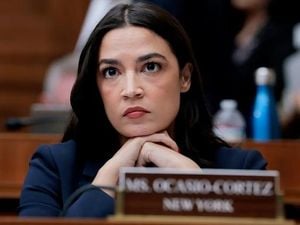Over the past few years, autonomous vehicle technology has burgeoned, transforming the automotive industry and changing how we think about transportation. But, as exciting as these advancements are, they come wrapped in layers of legal and regulatory challenges. The dance between innovators like Tesla and regulatory figures continues to evolve, especially as key personalities weigh their concerns against ambitious future technologies.
Elon Musk, the CEO of Tesla, has been at the forefront of this wave of innovation. At the recent "We, Robot" event, Musk unveiled Tesla's next-generation driverless taxis, dubbed the Cybercab, along with the Robovan, showcasing zero dependence on human interaction. Yet, these developments are marred by the contrasting views being voiced, particularly from influential figures such as Donald Trump. During remarks at the Detroit Economic Club, Trump expressed his apprehensions about autonomous vehicles, signaling his intent to halt their proliferation if he returns to the presidency. "I will stop Chinese — and other countries — produced automobile and autonomous vehicles," he proclaimed.
Just hours after Trump's remarks, Musk announced the highly anticipated Cybercab, highlighting the stark difference between their views. While Musk is pushing for the future of fully autonomous vehicles to become ubiquitous on roads—he's even targeting full self-driving capabilities for the Model 3 and Model Y by next year—Trump's stance brings uncertainty to those ambitions.
This clash isn't just symbolic; it points to the larger tension enveloping the autonomous vehicle sector. Many companies are currently racing to develop and deploy their autonomous technologies, seeing opportunities not just within the U.S. but globally. Alphabet's Waymo has been leading the charge, providing fully autonomous rides in cities like San Francisco and Phoenix, with plans to expand to Los Angeles and Austin soon. Meanwhile, General Motors' Cruise is tentatively re-entering the market after previous setbacks have made caution imperative.
Adding complexity to this already charged environment are international players. Some Chinese firms are also ramping up operations and testing their own autonomous vehicles. Reports indicate companies like WeRide and Didi have logged considerable testing miles on U.S. roads, creating another level of competition against American firms.
But the regulations surrounding these innovations can sometimes hamper progress. Each country has its own set of principles governing the deployment of autonomous vehicles, with many requiring strict testing and licensing protocols to control when and where these vehicles can operate. For example, Tesla is required to meet various regulations before rolling out its vehicles on public roads, with mapping licenses being one such significant hurdle for foreign companies entering China.
China's stronghold over the self-driving market could prove problematic for U.S. companies. This was evidenced recently when Bosch, the German auto parts manufacturer, entered the Chinese market, signing agreements with Tencent to collaborate on autonomous driving technology. Chinese entities have captured key partnerships aimed at pushing the limits of self-driving vehicles.
Technologically, the changes are relentless. With teleoperation gaining traction, innovations like SpaceX's Starlink could facilitate remote operation of autonomous vehicles, leaning heavily on inexpensive labor from remote locations. Imagine someone operating hundreds of autonomous taxis from thousands of miles away—a tantalizing prospect but one laden with ethical quandaries.
The prospect of teleoperated vehicles opens new doors for liability and safety issues. Who is responsible if something goes wrong? The operator controlling vehicles from far away, the company providing the services, or the vehicle itself? These unanswered questions leave not just regulators but the public at large pondering potential ramifications. Currently, the regulatory framework struggles to keep pace with technology, raising fears of increased accidents and operational failures.
Musk's ideas around teleoperation include finding economical ways to take drivers out of the equation. This could potentially signify the democratization of labor to unprecedented levels, affecting job markets across various sectors. The thought of $10-a-day operators remotely managing fleets raises valid concerns about fair wages, job replacement, and economic sustainability.
On the other side of the spectrum, safety and trust hang heavily around self-driving vehicles. Musk claims Tesla's technology will eventually surpass human drivers both safely and efficiently, offering financial gains to owners, yet the path to demonstrating this reliability is fraught and complicated. Recent investigations by the Department of Justice and the Securities and Exchange Commission probe Tesla's claims about their automation technologies, with past incidents casting doubt on whether such systems can achieve full autonomy.
Another chapter to this narrative involves ethical business practices. Critics have pointed fingers at tech giants for prioritizing financial gain over public safety, citing the premature deployment of vehicles without the adequate safety measures. The ever-growing competition invites not just innovation but also the potential for shortcuts, which could have disastrous consequences for users on the road.
With recent developments, news from the industry highlights continued collaborations. Partnerships among firms like Tesla, Baidu, and Bosch signify not just the global nature of autonomous technology but also point to the necessity for cooperative endeavors to drive standardization and regulation, integrating efforts to make road safety the foundation beneath new innovations rather than just the afterthought.
With autonomous vehicle technology advancing rapidly alongside shifting regulatory concerns, the interplay between innovators and regulators continues to evolve. This complication, paired with overarching global ambitions, indicates we're on the cusp of significant transformations. The next few years will likely reveal how these technologies can harmonize within societal frameworks, addressing not only the opportunities they bring but also the challenges they create.
The industry awaits with bated breath as the government outlines its regulatory framework, reflecting on the necessity for collaboration, innovation, and safety. Can developers like Tesla and Waymo continue to push boundaries without faltering under regulatory pressure? Time will tell as the world of autonomous vehicles gains momentum, striving for highways crowded with eco-friendly, driverless cabs. It's all up for discussion, with debates blazing over the lengths to which we can—and should—transform our roads.



